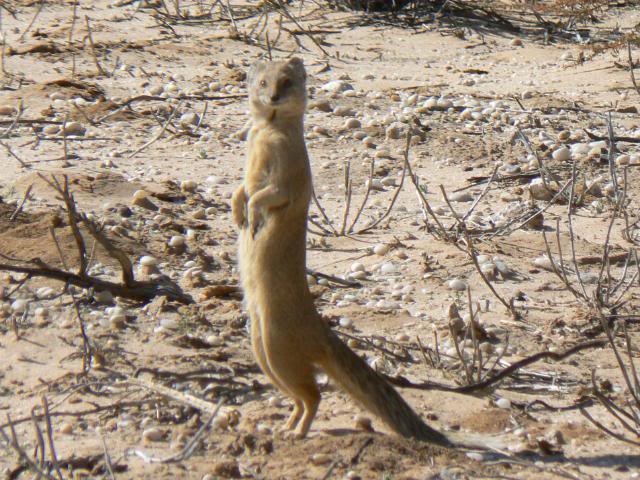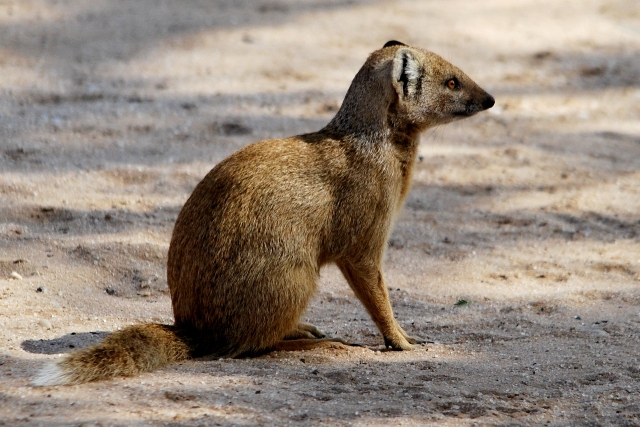Yellow Mongoose
- nan
- Posts: 26307
- Joined: Thu May 31, 2012 9:41 pm
- Country: Switzerland
- Location: Central Europe
- Contact:
Re: Mongoose - Animal of the Month: March 2014
Kgalagadi - 22.4.2007
Yellow Mongoose



Yellow Mongoose



Kgalagadi lover… for ever
https://safrounet.piwigo.com/
https://safrounet.piwigo.com/
- nan
- Posts: 26307
- Joined: Thu May 31, 2012 9:41 pm
- Country: Switzerland
- Location: Central Europe
- Contact:
Re: Mongoose - Animal of the Month: March 2014
Addo 2012
Yellow Mongoose – 16.10.2012



Yellow Mongoose – 16.10.2012



Kgalagadi lover… for ever
https://safrounet.piwigo.com/
https://safrounet.piwigo.com/
- nan
- Posts: 26307
- Joined: Thu May 31, 2012 9:41 pm
- Country: Switzerland
- Location: Central Europe
- Contact:
Re: Mongoose - Animal of the Month: March 2014
my friend at KTC
Yellow Mongoose
 16.9.2012
16.9.2012
 11.3.2013
11.3.2013
just caught a mice in the kitchen, then going to its "house", and comes back
 8.3.2013
8.3.2013

Yellow Mongoose
 16.9.2012
16.9.2012  11.3.2013
11.3.2013just caught a mice in the kitchen, then going to its "house", and comes back
 8.3.2013
8.3.2013
Kgalagadi lover… for ever
https://safrounet.piwigo.com/
https://safrounet.piwigo.com/
- nan
- Posts: 26307
- Joined: Thu May 31, 2012 9:41 pm
- Country: Switzerland
- Location: Central Europe
- Contact:
Re: Mongoose - Animal of the Month: March 2014
the last ones... before the Giraffes




Kgalagadi lover… for ever
https://safrounet.piwigo.com/
https://safrounet.piwigo.com/
Yellow Mongoose
Yellow Mongoose Cynictis penicillata
Order Carnivora. Family Herpestidae

The Yellow Mongoose is the only member of the genus Cynictis, but as many as 12 sub-species have been described based on variations in colour, size and the length of the hair and tail. Taxonomic status of these subspecies is, however, unclear, with several authors reporting equivocal taxonomic revisions. Skinner & Chimimba (2005) listed four subspecies after Taylor (1990) and these are C. p. penicillata (from South Africa, excluding Limpopo Province, the Northern Cape and KwaZulu-Natal), C. p. bradfieldi (from Namibia, the Northern Cape and southern Botswana), C. p. coombsii (from central and northern Botswana, north-eastern Namibia and Limpopo Province) and C. p. natalensis (from KwaZulu-Natal). The four sub-species are known to occur in southern Africa in Namibia, Botswana, South Africa and Lesotho. The Yellow Mongoose is solitary or occurs in pairs and they live in burrow systems in open, semi-arid areas. They are well adapted to living in subterranean habitats and have strong claws that are well suited for digging and grabbing food. Cynictis penicillata is relatively widespread and common in its natural range with no major threats.
Description
The Yellow Mongoose has a total length is 400-600 mm, with a tail length of 180-250 mm. Mass is about 450-900 g. Has a triangular shaped face with a pointed snout. When running the tail is held horizontal to the ground. Throughout the southern and central range the coat is a reddish-yellow to a tawny-yellow colour, and the fairly brushy tail has a very distinctive white tip. In the northern parts the tail is not as white tipped and the body colour is greyish. The paler chin, throat and upper chest prevails throughout the range.
Distribution
The yellow mongoose is restricted to southern Africa and they are known to occur in Namibia, Botswana, South Africa and Lesotho. In South Africa, they occur in all the provinces, but in Limpopo they are restricted to the western areas of the province and in KwaZulu-Natal an isolated population occurs in the north-western part of the province.
Habitat
The yellow mongoose inhabits open, semi-arid areas such as grasslands and scrub lands where they live in burrows. They are rarely found in deserts, forests or mountainous regions.
Diet
Yellow mongooses are opportunistic feeders and insects form the bulk of their diet, but they will also readily feed on amphibians, rodents and reptiles, including snakes and lizards. Yellow mongooses also eat carrion. The yellow mongoose is unique among mongooses in that it is the only known species that brings large prey items (e.g. rodents, bats or reptiles) to its young while they are still in the burrow.
Reproduction and Life Cycles
Yellow mongooses are seasonal breeders and females produce two litters annually, the first around October and the second litter between December and February. There are two to three pups per litter. When they occur in colonies or groups, several females may be reproductively active within the group and their oestrus cycle is highly synchronised with copulation taking place within a two-day period. The gestation period is 60–62 days. The onset of the second oestrus occurs during the lactation period when pups are suckled for six to eight weeks. After eight weeks, the weaned pups accompany adults for foraging for the first time and they become nutritionally independent at 16–18 weeks.
Social Life
Yellow mongooses usually occur singly or as pairs, the exception being during the breeding season when the young produced that year stay within a group. Sociality allows for reduced predation among the juveniles. Burrows can be interconnected and may be occupied by a colony of eight to ten mongooses. Subordinate males disperse to neighbouring territories when mature. The home ranges of males may overlap with several female home ranges, but the home ranges of females from different dens do not overlap.
Yellow mongooses frequently share warrens with ground squirrels (Xerus inauris) and suricates (Suricata suricatta).
Smart Strategies
1. Yellow mongooses are able to supplement their diet with fruits, nuts and seeds. They are also creative hunters that are known to break open bird eggs by throwing them with their forepaws towards a solid rock or any hard object.
2. They live in burrows, which are used as shelter from extreme weather conditions and refuge from predators. Yellow mongooses are also known to share their burrows with other species such as ground squirrels and suricates. This cooperative living arrangement may promote vigilance and reduce predation risk.
3. They can forage far from their primary burrows, but when threatened during the foraging trips they retreat to temporary refuge burrows within their home range or they simply use any nearby hole for shelter.
Order Carnivora. Family Herpestidae

The Yellow Mongoose is the only member of the genus Cynictis, but as many as 12 sub-species have been described based on variations in colour, size and the length of the hair and tail. Taxonomic status of these subspecies is, however, unclear, with several authors reporting equivocal taxonomic revisions. Skinner & Chimimba (2005) listed four subspecies after Taylor (1990) and these are C. p. penicillata (from South Africa, excluding Limpopo Province, the Northern Cape and KwaZulu-Natal), C. p. bradfieldi (from Namibia, the Northern Cape and southern Botswana), C. p. coombsii (from central and northern Botswana, north-eastern Namibia and Limpopo Province) and C. p. natalensis (from KwaZulu-Natal). The four sub-species are known to occur in southern Africa in Namibia, Botswana, South Africa and Lesotho. The Yellow Mongoose is solitary or occurs in pairs and they live in burrow systems in open, semi-arid areas. They are well adapted to living in subterranean habitats and have strong claws that are well suited for digging and grabbing food. Cynictis penicillata is relatively widespread and common in its natural range with no major threats.
Description
The Yellow Mongoose has a total length is 400-600 mm, with a tail length of 180-250 mm. Mass is about 450-900 g. Has a triangular shaped face with a pointed snout. When running the tail is held horizontal to the ground. Throughout the southern and central range the coat is a reddish-yellow to a tawny-yellow colour, and the fairly brushy tail has a very distinctive white tip. In the northern parts the tail is not as white tipped and the body colour is greyish. The paler chin, throat and upper chest prevails throughout the range.
Distribution
The yellow mongoose is restricted to southern Africa and they are known to occur in Namibia, Botswana, South Africa and Lesotho. In South Africa, they occur in all the provinces, but in Limpopo they are restricted to the western areas of the province and in KwaZulu-Natal an isolated population occurs in the north-western part of the province.
Habitat
The yellow mongoose inhabits open, semi-arid areas such as grasslands and scrub lands where they live in burrows. They are rarely found in deserts, forests or mountainous regions.
Diet
Yellow mongooses are opportunistic feeders and insects form the bulk of their diet, but they will also readily feed on amphibians, rodents and reptiles, including snakes and lizards. Yellow mongooses also eat carrion. The yellow mongoose is unique among mongooses in that it is the only known species that brings large prey items (e.g. rodents, bats or reptiles) to its young while they are still in the burrow.
Reproduction and Life Cycles
Yellow mongooses are seasonal breeders and females produce two litters annually, the first around October and the second litter between December and February. There are two to three pups per litter. When they occur in colonies or groups, several females may be reproductively active within the group and their oestrus cycle is highly synchronised with copulation taking place within a two-day period. The gestation period is 60–62 days. The onset of the second oestrus occurs during the lactation period when pups are suckled for six to eight weeks. After eight weeks, the weaned pups accompany adults for foraging for the first time and they become nutritionally independent at 16–18 weeks.
Social Life
Yellow mongooses usually occur singly or as pairs, the exception being during the breeding season when the young produced that year stay within a group. Sociality allows for reduced predation among the juveniles. Burrows can be interconnected and may be occupied by a colony of eight to ten mongooses. Subordinate males disperse to neighbouring territories when mature. The home ranges of males may overlap with several female home ranges, but the home ranges of females from different dens do not overlap.
Yellow mongooses frequently share warrens with ground squirrels (Xerus inauris) and suricates (Suricata suricatta).
Smart Strategies
1. Yellow mongooses are able to supplement their diet with fruits, nuts and seeds. They are also creative hunters that are known to break open bird eggs by throwing them with their forepaws towards a solid rock or any hard object.
2. They live in burrows, which are used as shelter from extreme weather conditions and refuge from predators. Yellow mongooses are also known to share their burrows with other species such as ground squirrels and suricates. This cooperative living arrangement may promote vigilance and reduce predation risk.
3. They can forage far from their primary burrows, but when threatened during the foraging trips they retreat to temporary refuge burrows within their home range or they simply use any nearby hole for shelter.
- nan
- Posts: 26307
- Joined: Thu May 31, 2012 9:41 pm
- Country: Switzerland
- Location: Central Europe
- Contact:
Re: Yellow Mongoose - Animal of the Month March 2015
superb choice 
will try to post some... now I have finished (well almost) my french blog
will try to post some... now I have finished (well almost) my french blog
Kgalagadi lover… for ever
https://safrounet.piwigo.com/
https://safrounet.piwigo.com/
- Mel
- Global Moderator
- Posts: 28224
- Joined: Sat May 19, 2012 12:31 pm
- Country: Germany
- Location: Föhr
- Contact:
Re: Yellow Mongoose - Animal of the Month March 2015
Dikbaardskolk picnic spot on 23/03/2010, quite tame that one and a little beggar.
Learning by doing, I suppose

Learning by doing, I suppose

God put me on earth to accomplish a certain amount of things. Right now I'm so far behind that I'll never die.


